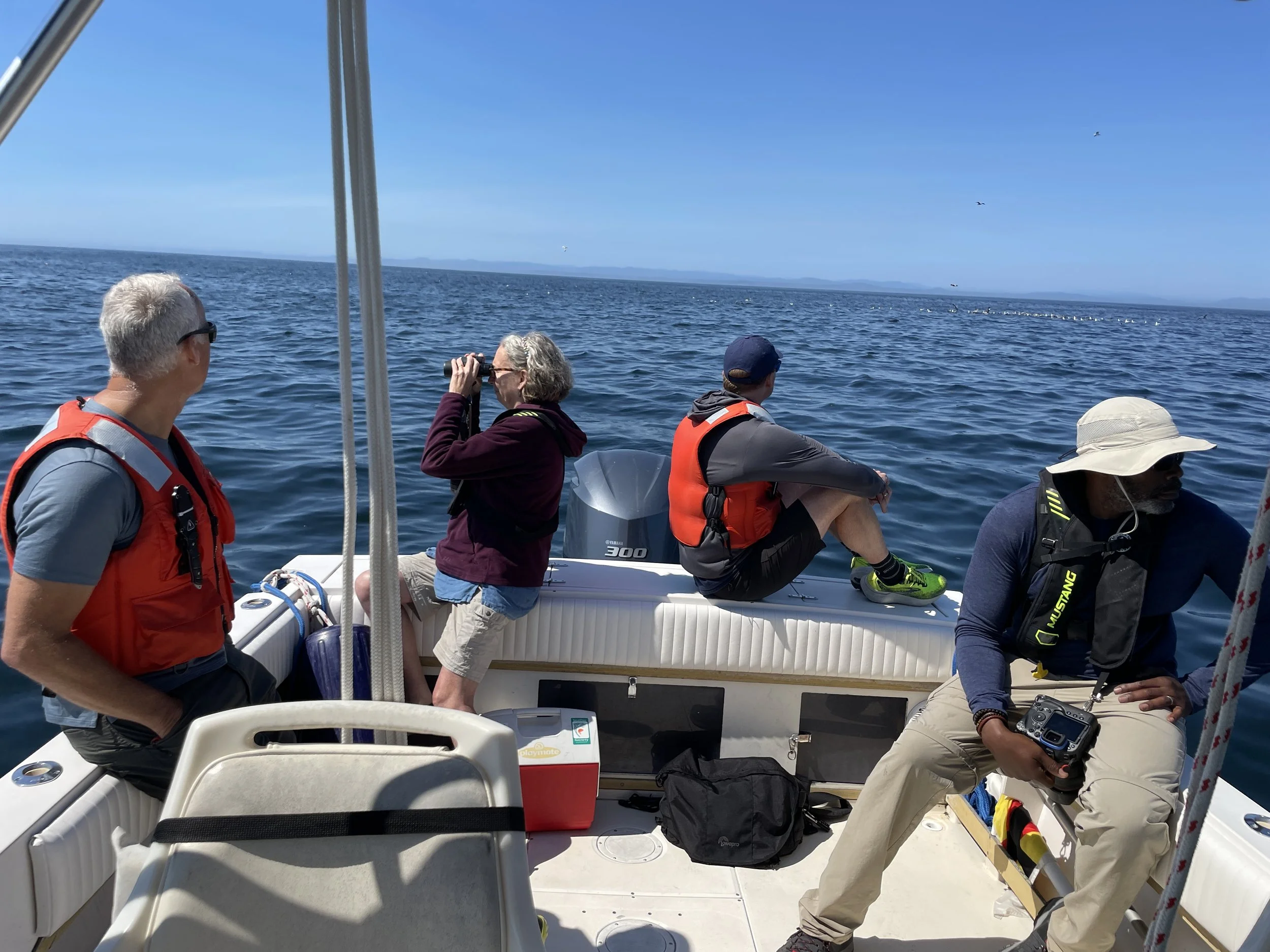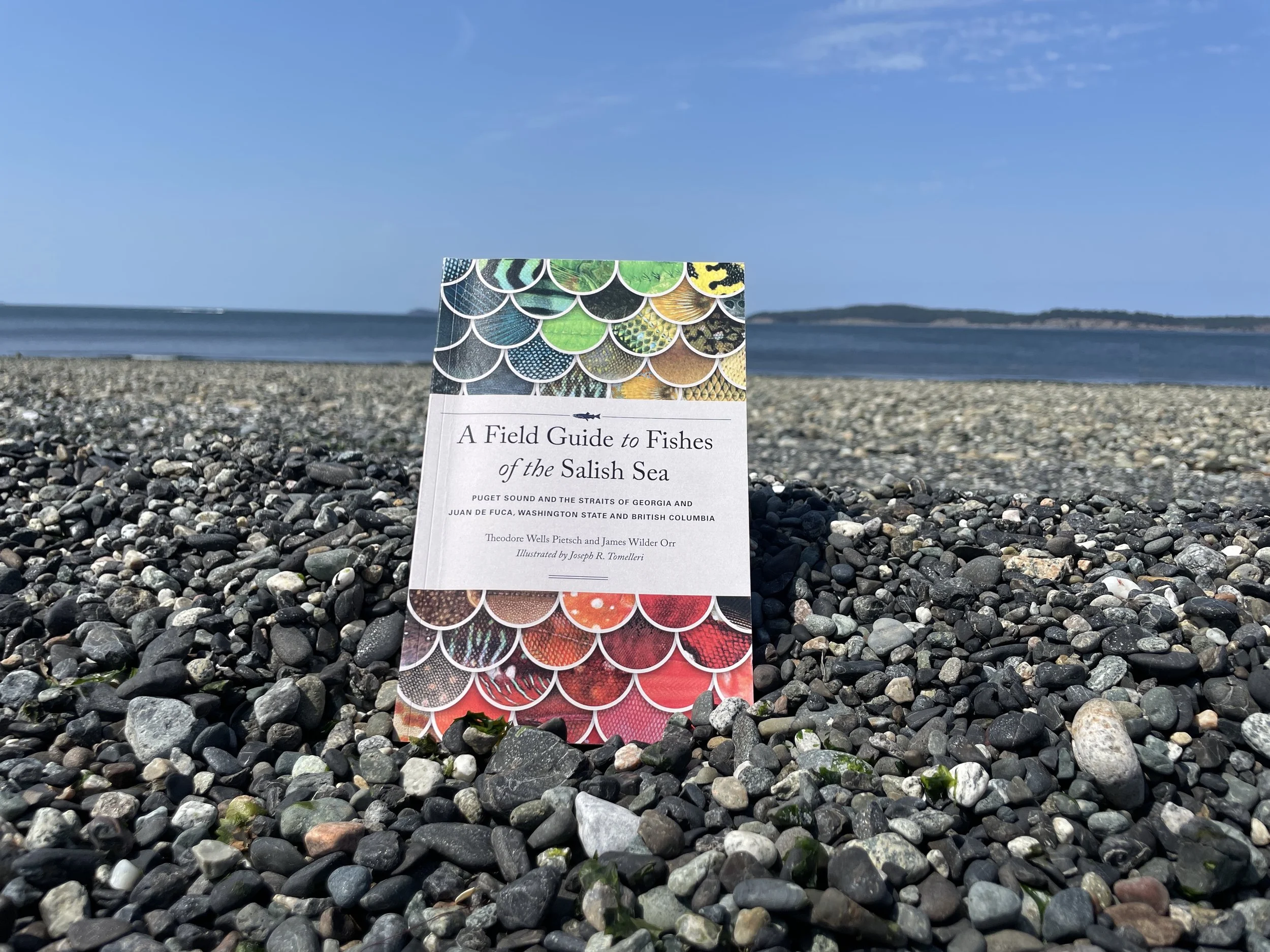Check out this velcro star with a spotted ratfish locked in a full nelson! SeaDoc Society scientists Joe Gaydos and Cat Lo came across this scene during a research dive in Howe Sound in British Columbia.
Training The Trainers at Camp Orkila
Thousands of fifth-graders will cycle through Camp Orkila on Orcas Island this summer to engage with our marine ecosystem. As we round the corner into Spring, the counselors who will guide those kids (5,800 total!) are deep in preparation and training.
Last week, our team was honored to lead a low-tide beach walk at Camp Orkila to train this year’s Orkila staff. All of the counselors received a signed copy of our best-selling (and award-winning!) book for fifth graders, Explore the Salish Sea: A Nature Guide for Kids.
Rochelle Severson and Kevin Campion Cycle off SeaDoc Board; Ardi Kveven is New Board Chair
Farewell Southern Resident IPA & Thank You Two Beers Brewing
As I write this, sitting in The Woods taproom where Southern Resident is brewed, Two Beers has donated more than $15,000 in support of the SeaDoc Society’s collaborative work to save Southern Residents.
Not to mention the story they’ve helped tell on thousands of boxes and cans sold throughout the Pacific Northwest over the last five years. In that initial creative design phase, their team was insistent that the whales’ story and SeaDoc’s mission be clear and prominent on the packaging.
Why are Killer Whales Harassing and Killing Porpoises Without Eating Them?
For decades, fish-eating killer whales in the Pacific Northwest have been observed harassing and even killing porpoises without consuming them—a perplexing behavior that has long intrigued scientists.
A study published today in Marine Mammal Science, co-led by Deborah Giles of Wild Orca and Sarah Teman of the SeaDoc Society, a program of the UC Davis School of Veterinary Medicine, looked at more than 60 years of recorded interactions between Southern Resident killer whales and porpoises in the Salish Sea to better understand why they exhibit this behavior.
Field Notes: Behind the Humpback Comeback Story
It occurred to me as we bobbed around Hein Bank that even though we weren’t staring at literal humpback whales, we had been circling their story for hours. The cacophony of seabirds that ribbonned out across the channel for hundreds of yards was not there by accident. They were feasting on the same forage fish that make the Salish Sea a habitable home for humpback whales.
Lost Fishing Net Strewn Across the Salish Sea Floor Near San Juan Island
On a recent research dive near San Juan Island, SeaDoc Society Science Director Joe Gaydos captured video of a large fishing net clinging to the rocky ocean floor. We immediately reported the net to the on-line, no fault reporting hotline so they can begin the process of removal, which is a complex and dangerous job - even for trained professionals.
2023 Was our Biggest Wine & Sea Auction Yet!
Big thanks to all who attended our annual Wine & Sea Auction on Orcas Island last weekend! It was so wonderful to celebrate together on a beautiful Saturday afternoon—all in support of Salish Sea science and conservation! Huge thanks also to our amazing hosts, sponsors, board members and volunteers, it was our most successful auction ever!
2023 Octopus Award: Martha Kongsgaard and Stephanie Solien
The purpose of the Octopus Award is to recognize individuals outside our program (i.e., not serving on the Board or in any kind of formal capacity) who have made significant contributions to the success of the SeaDoc Society and our mission in the Salish Sea. Past recipients include Malcolm Goodfellow (2004), Patti Moran-Hodge (2005), John Klacking (2007), Lynne Greene (2008), Compass Wines (Doug Charles and Will Parks, 2010), Bennie Osburn (2011), and Chris Dunnigan (2015).
2023 Honorees: Martha Kongsgaard and Stephanie Solien
Pacific Bluefin Tuna Found on Orcas Island Beach (PHOTOS/VIDEO)
How did you start your day? Was it by looking at a massive #bluefin tuna that washed up on the beach near your home? That’s how we did! That’s right, we woke up to find this beautiful bluefin tuna dead on Crescent Beach in Eastsound—right here on Orcas Island.
A Field Guide to Fishes of the Salish Sea (Book Review by Joe Gaydos)
The waters of the Salish Sea are deep and cold and can move as fast as 8 kts in some places when the tide is running. While these attributes are key to making our inland sea so biologically productive, they also paint an image of foreboding water for some. Unfortunately, people also mistakenly presume that the fishes of these waters are as dark and murky and unwelcoming as the water itself. I predict that this misconception about our local fishes is going to change with the recent release of Ted Pietch and Jim Orr’s A Field Guide to Fishes of the Salish Sea.
Our Heartfelt Condolences
Our thoughts are with the friends and family of those who were aboard the Titan submersible that was lost in the North Atlantic last week.
In 2018, The SeaDoc Society funded three deep sea scientific research projects in the San Juan Islands that would not have been possible without OceanGate’s submersible technology and their professional team. OceanGate’s Cyclops 1 submersible enabled scientists to safely visualize the deep ecosystems of the Salish Sea and better study red urchins, sand lance, and the impact of scientific trawling on the seafloor.
“In their hearts, they were scientists,” SeaDoc Society Science Director Joe Gaydos told The Washington Post last week. “Stockton wanted to make a difference … He wanted to do things that actually made the ocean better.” …
SeaDoc Society to Fund Six Critical Research Projects
Science is the vital first step in driving positive change for wildlife, people, and the environment. All efforts to change hearts, minds and policy flow from solid data.
This year, SeaDoc Society will fund six new scientific research projects that will ultimately improve the health of the Salish Sea. Each project was carefully reviewed and selected by our Science Advisors and funded thanks to all sizes of SeaDoc Society donations.
Each project is funded at the level of $50,000 and will answer questions where more information is most likely to improve our ability to recover or manage important living resources. In addition to producing quality science to be published in peer-reviewed journals, each project also will meet the criteria most often associated with research that has a positive conservation impact.
The Salish Sea: Jewel of the Pacific Northwest is Back by Popular Demand!
After much demand, the best-selling book The Salish Sea: Jewel of the Pacific Northwest by SeaDoc Board Member Audrey Benedict and Science Director Joe Gaydos is being re-released by its publisher, Sasquatch Books!
Starting this month you can find copies of this award-winning book online and in bookstores throughout the Pacific Northwest. The Salish Sea received the prestigious Nautilus Gold Award in the category of Ecology and Environment, was a Pacific Northwest Independent Bestseller, and garnered rave reviews in the Seattle Times, Vancouver Sun, Cascadia Weekly, and other regional news outlets. To date, the book has sold more than 20,000 copies.
Ocean Night: Right Over the Edge on May 18th
The SeaDoc Society will bring back their popular Ocean Night series at the SeaView Theatre on Orcas Island Thursday May 18 at 7 p.m. The debut event will feature the new film Right Over the Edge: Search for the North Pacific Right Whale. Admission is free.
Right Over the Edge was created by Kevin Campion, filmmaker and founder of Deep Green Wilderness, which takes kids out to sea to learn about science, whales and the Salish Sea. Campion will be in attendance to introduce the film and take questions.
Superpod: Saving the Endangered Orcas of the Pacific Northwest (Book Excerpt)
Nora Nickum is Senior Ocean Policy Manager with the Seattle Aquarium and author of the new book, Superpod: Saving the Endangered Orcas of the Pacific Northwest. She’s an extremely valuable person to have in the larger effort to save this species, both in her policy work and in writing this book, which will no-doubt help shape the next generation of PNW conservationists.
“Full of scientist and activist heroes, including Nickum herself, Superpod will captivate readers and inspire them to become change makers,” said SeaDoc Society Science Director Joe Gaydos, whose field work is featured in an excerpt of the book below this short Q&A.
Book Review: Between the Tides in Washington and Oregon
Kelly, Klinger and Meyer are marine biologists. The real deal. They’ve spent most of their lives exploring and studying beaches and oceans. But their recent book, Between the Tides in Washington and Oregon, isn’t for pointy headed marine ecologists who study the minute details of riotous complexity of life that graces the coastline in this region. While scientifically on-point and detailed enough for a young marine biology student studying intertidal ecology, this book is really aimed at the average Joe. The non-expert. The newcomer or the dad or mom that want to explore the “why” with their kids as they journey to the ocean. This book won’t tell you the names of the thousands of plants and animals you’ll find at the shoreline. It’s bigger than that. This book will help you be a shoreline detective and increase your happiness index while at the beach.
Ocean Explosion: Protecting the Salish Sea With Ice Cream
Salish Sea stewardship comes in all forms, but the first step to caring for something is learning about it! A few weeks ago, seven classes from a school in Victoria, BC shared with their friends, family, and community what they had learned this fall when their teachers had them answer the question “How can I be a steward of the Salish Sea?” Students were encouraged to research an aspect of the Salish Sea and come up with ways that they could protect it — and they got creative!
Meet Our New Research Assistant, Catherine Lo!
We’re so excited to introduce our newest Research Assistant, Catherine Lo!
Cat’s predecessor, Sarah Teman, started her PhD program at the University of Washington this fall and we can’t wait to watch her bright future unfold! Like Sarah, Cat will work alongside Joe Gaydos on all things science and research here at SeaDoc Society. She joins us on Orcas Island this fall and has hit the ground running!
“Cat comes to SeaDoc with strong research skills and experience in data collection, data analysis, project management, scientific writing, and field work,” said SeaDoc Science Director Joe Gaydos. “Plus she loves the ocean and is a delightful person to work with. What’s not to like about that?”
Dramatic Rescue: Sea Lion Suffers Deadly Entanglement (VIDEO)
When a big male Steller sea lion was spotted near San Juan Island with a plastic packing strap slicing deep into his neck, the only chance to save him was to launch a risky rescue mission. Today, footage of that dramatic operation is being made public for the first time.
The latest episode of Salish Sea Wild – a wildlife documentary series about the Salish Sea produced by the SeaDoc Society – puts you out on the water with the team as they work to sedate and free the 500-pound animal while battling huge tides, dangerous currents and jagged rocks.















